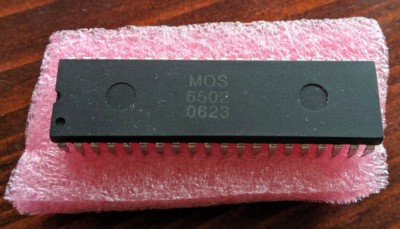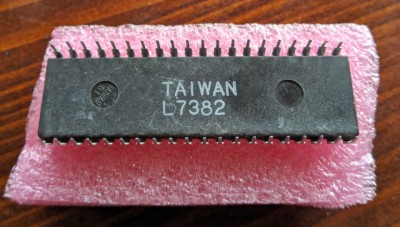Hi!
For amusement, I purchased a very cheap 6502 from an aliexpress seller, from the photo I already expected it to be fake:
https://www.aliexpress.com/item/33021360734.htmlThis is what I received:
Attachment:
File comment: IC top view
 ic-top.jpg [ 96.19 KiB | Viewed 3584 times ]
ic-top.jpg [ 96.19 KiB | Viewed 3584 times ]
Attachment:
File comment: IC bottom view
 ic-bottom.jpg [ 102.16 KiB | Viewed 3584 times ]
ic-bottom.jpg [ 102.16 KiB | Viewed 3584 times ]
Well, it seem it is a relabeled chip, time to do research!. Tested with a multimeter, pins 5, 35 and 36 are N/C, and pin 8 is VDD, so it seems a real 6502. So, I attached it to a breadboard with 1MHz clock signal, resistors at the inputs and some logic analyzer probes:
Attachment:
File comment: Probing the IC
 ic-probe.jpg [ 154.76 KiB | Viewed 3584 times ]
ic-probe.jpg [ 154.76 KiB | Viewed 3584 times ]
First, data bus set to $EA (a simple NOP), this is the trace, blue vertical line marks the start of RESET:
Attachment:
File comment: Trace $EA
 mos6502-EA.png [ 45.19 KiB | Viewed 3584 times ]
mos6502-EA.png [ 45.19 KiB | Viewed 3584 times ]
It behaves like a proper 6502, but at closer examination the RESET sequence actually
writes to the stack, this is not supposed to happen in a NMOS 6502.... so I tested the data bus set to $FA (invalid on the NMOS 6502, PLX in the 65C02):
Attachment:
File comment: Trace $FA
 mos6502-FA.png [ 45.5 KiB | Viewed 3584 times ]
mos6502-FA.png [ 45.5 KiB | Viewed 3584 times ]
It is a PLX, this means this is a 65C02. And setting the data bus to $FF, I got this:
Attachment:
File comment: Trace $FF
 mos6502-FF.png [ 47.32 KiB | Viewed 3584 times ]
mos6502-FF.png [ 47.32 KiB | Viewed 3584 times ]
A one cycle NOP. So, this is not a newer 65C02, is an original 65C02 without the Rockwell extensions. Searching online, the only 65*02 that is documented to write to the stack on reset is the "G65SC02".
My questions: Do anyone know of other possibilities? Is there any other test I could do to properly identify the chip?
Have Fun!







